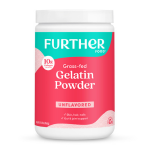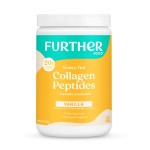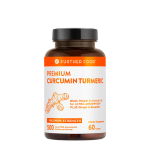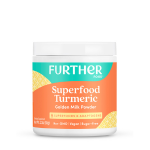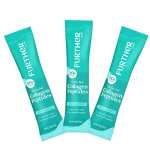I was twenty-four years old, in school training to become a doctor and working as a clinical nutritionist just outside of Orlando, Florida, when I received a phone call from home. My mother, Winona, was on the line, and she sounded upset. “What’s wrong, Mom?” I asked. “The cancer has come back,” she said through tears.
My heart sank, and I was immediately transported back to my seventh-grade year, when my mom was told that she had stage-4 breast cancer that had spread to her lymph nodes. The news was not only a devastating blow to me, as her son—but it was also a shock to anyone who knew her. At the time, my mom was forty-one years old; she was my gym teacher at school and a swim instructor. Everyone thought she was the picture of fitness and health.
Soon after her diagnosis, my mom underwent a total mastectomy of her left breast and started the first of what would be four cycles of chemotherapy that left her too weak to get out of bed in the days that followed. It was painful to see how sick she got on chemo. I remember walking into the bathroom one day and seeing clumps of her sandy-blond hair on the floor. She looked like she had aged twenty years in two weeks. Thankfully, months later she was declared cancer-free, but her health continued to spiral downward. Even after bouncing back from chemotherapy and returning to her job, she felt lousy.
Every day, she would get home at three thirty in the afternoon and nap until dinner time. We’d eat together but she struggled to stay awake and would turn in for the night soon after. When she told her doctor that she couldn’t cope with being a wife, mother, and schoolteacher, he prescribed an antidepressant. Depressed and exhausted: this was the mother I knew throughout my teenage years. She lived in fear that the cancer would return. And now, ten years later, it had. Her distressed voice shook me back to the present. “My oncologist told me they found a tumor on my lungs that was 2.5 centimeters,” she said. “He wants to do surgery and start radiation and chemotherapy right away.” I tried to be as encouraging as possible. “Mom, please don’t worry. Your body has the ability to heal,” I said. “We just need to stop feeding the cancer cells and get to the root cause of the disease.” I was confident her health could be restored—but, in order to do that, we’d need to take care of her whole body. The next day, I flew home to help her lay out a health program.
I asked her to tell me about any symptoms she had been experiencing in the time leading up to her diagnosis. She sighed. “Well, I’m still struggling with depression,” she said. “And even if I get a good night’s sleep, I’m always tired the next day.” She described symptoms that indicated she had multiple food sensitivities. She also revealed that she’d been diagnosed with hypothyroidism. All of this was quite troubling—but it was her last symptom that shocked me. When I asked about her digestive habits, she revealed that she’d had an average of one to two bowel movements a week, for the last ten years. “Wow, Mom,” I said, stunned. “Why didn’t you talk to your doctor about this earlier?” “I thought it was normal,” she said. Her face crumpled. I reached out for her hand and told her not to be discouraged. “Mom,” I said, “this is actually good news. We can definitely do something about your digestion, and that alone will make a big difference in how you’re feeling.” And hopefully will help stop the cancer, too, I thought.
I told my mother about leaky gut syndrome—a condition in which the intestinal wall breaks down, allowing microbes and food particles to leak out of the digestive tract, triggering an inflammatory immune response—and how dangerous it was. I told her I believed it was the cause of her constipation and several other health problems, and that we needed to address it immediately. “We can do this, Mom,” I said. “Come on.” I stood up and asked her to follow me into the kitchen.
I grabbed a black garbage bag and opened kitchen cupboards. “We’re starting all over,” I announced. “From now on, you’re not eating anything that comes out of a box.” Together, we threw out every processed food we could find:
▶▶ boxed cereals like Honey Nut Cheerios and Honey Bunches of Oats (she thought these cereals were healthy)
▶▶ plastic bottles of Juicy Juice billed as “90 percent real fruit juice” but made with apple juice concentrate and “natural” flavors that weren’t natural at all
▶▶ chips and crackers made with MSG and genetically modified corn
▶▶ cereal bars made with high fructose corn syrup, artificial colors, and soy protein
▶▶ salad dressings with artificial thickeners, emulsifiers, and hydrogenated oils
▶▶ bags of highly refined white sugar and white flour
Then we attacked the refrigerator and tossed out condiments, sauces, margarine, coffee creamers, mayonnaise, and conventional dairy items such as skim milk and processed cheese (“American cheese”) singles. Altogether, we threw out three huge garbage bags of processed foods. Then we drove to a local health food store, where I walked her through the aisles and talked her through the types of foods she should be eating to help support her body in its fight to kill the cancer cells.
We selected organic vegetables and berries, wild-caught salmon, pasture-raised chicken, and “clean” pantry staples—all organic foods with as few ingredients and as little processing as possible. Then we drove to another health food store, where we picked up nutritional supplements like turmeric, immune-boosting mushrooms, vitamin D3, and frankincense essential oil. At that time, the mainstream antibacterial craze was at its height, and almost every product in conventional grocery stores—from floor cleaner to toothpaste to number-two pencils—seemed to have added antibacterial ingredients. Scientists had started to sound the alarm about the overprescription of antibiotics causing resistance to some strains of illnesses, and the danger of overly sterile environments to our immune systems, but their research wasn’t trickling down to most neighborhoods just yet.
The evidence of these issues was showing up every day in my natural medicine practice, though. For several years I had seen the collateral damage these antibacterials and other supposedly “sanitary” chemicals were causing. If part of the problem centered on being too clean, I felt certain the solution must be the opposite—to get dirty. To consciously create repeated “microexposures” to dirt that held long-lost bacteria, viruses, and other microbes that could function as nature’s immunizations.
To fortify and replenish the beneficial bacteria our bodies lost during the onslaught of antibacterial products in our environment. To completely reeducate the immune system, so it could once again learn how to defend itself without going overboard. To not be afraid of a little dirt here and there, but instead, more consciously follow the rhythms of nature and embrace the healing power that surrounds us every day. And so, to start Mom’s healing program, I went straight for the dirt.
In my years of medical research, I’d developed a special interest in probiotics—supplements and foods rich in healthy microorganisms, bacteria, fungi, and yeast that tip the overall balance of our gut microbiota toward health. One of the most novel and interesting threads of research I’d found centered on microorganisms in soil, which possesses many vital microbes often missing in the human body.
Right away, I started my mom on a probiotic supplement with soil-based organisms (SBOs) believed to improve the absorption of nutrients, eliminate yeast overgrowth, and improve bowel function. Then I brainstormed other ways for my mom to “get dirty.” She liked to ride horses growing up, so she headed back to the stables and began riding regularly, breathing in dust and grooming the horses. We also visited the farmer’s market to pick up organic, locally grown produce that had traveled less than ten miles from the farm.
The vegetables were vibrant with antioxidants and had clumps of soil still clinging to their roots. In her kitchen, I taught my mom how to make green drinks with servings of spinach, celery, cucumber, cilantro, lime, green apple, and stevia. She consumed a daily regimen of supplements, high-quality extracts derived from medicinal plants. She downed many cups of bone broth soup, the healing elixir made from the bones and innards of chicken, beef, lamb, or fish—animal parts previously considered dirty waste, now known to be an excellent source of collagen, glutamine, and other nutrients that help “heal and seal” the lining of the gut. She spent time outside in her garden every day, digging in the flower beds, or simply being still and giving thanks. I have to hand it to Mom—she followed my diet and lifestyle advice very closely. She also did natural treatments such as lymphatic massage and chiropractic care. And over the next several months, she saw many positive changes in her health: her constipation problems resolved, and she began having one bowel movement every day. She noticed a major upswing in her energy. Her thyroid issues disappeared. She lost twenty-two pounds, and she no longer felt depressed. She reported feeling more joy than she had ever experienced.
When my mom went in four months later for a CT scan, her surgeons were mystified by the results. Not only was her blood work normal, her cancer markers had dropped dramatically. “What’s happened is very unusual,” the oncologist said, with obvious surprise. “We don’t see cancer shrink very often.” Her largest tumor had shrunk by 52 percent. The oncologist encouraged her to keep doing what she was doing, “because whatever it is, it’s working.” Her medical team decided to hold off on surgery. Mom was greatly relieved to avoid going under the knife again.
Now, I want to be clear: cancer is one of the most extreme health concerns any of us will ever face. I would never claim that my program “cured” my mom’s cancer. Many factors come into play with an outcome like hers, and she was very diligent about following the guidance and directions of her other doctors. But where her doctors’ instructions left off, her diet and lifestyle changes began. And I believe it is due to the integration of all of these factors that today—more than twenty years after she first learned she had breast cancer, and a decade after this second diagnosis—Mom is enjoying the fruits of her lifestyle changes.
About seven years after her second diagnosis, my mom and dad retired and moved to a house on a lake in Florida. Today, they enjoy water-skiing and hiking trails with new friends. Mom has run several 5K races with me (finishing in second and third place in her age group!). She is radiant and bursting with energy. Almost every time I see her, she marvels at how much her health has changed. She says she feels better in her sixties than she did in her thirties! I can’t tell you how grateful I feel for my mother’s health—she is and will always be my greatest inspiration. Those awful months of pain and agony she endured when she was first diagnosed with breast cancer were what made me decide to become a doctor.
And the experience of helping her heal her leaky gut—and subsequently overcome her hypothyroidism, chronic fatigue, depression, and cancer—crystallized my life’s mission as a medical professional. To me, her vibrant health makeover perfectly epitomizes the power of full-body healing that can take place when you first heal your gut. The protocol that she followed, the same approach I’ve used with thousands of patients, forms the backbone of the Eat Dirt program.
Excerpted with permission from Eat Dirt: Why Leaky Gut May Be the Root Cause of Your Health Problems and 5 Surprising Steps to Cure It by Dr. Josh Axe. Read more about Winona’s story, Dr. Axe’s solutions for leaky gut, and how to improve all aspects of your life through diet and lifestyle in Eat Dirt: Why Leaky Gut May Be the Root Cause of Your Health Problems and 5 Surprising Steps to Cure It.
Want to learn more? I Listened to My Doctor Instead of Listening to My Gut...Literally My Doctors Said They Couldn't Help My IBS and Leaky Gut. Here's How I Helped Myself. Recipe: Simple Honey Orange Salmon










